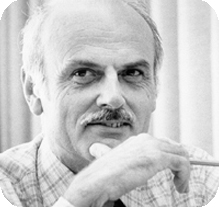
A.M. TURING AWARD WINNERS BY...
Edgar F. ("Ted") Codd

United States – 1981
Short Annotated Bibliography
Codd wrote some 60 technical articles and papers and two books and made valuable contributions in several distinct areas, including multiprogramming, natural language processing, and others. The following very short list concentrates on the papers in which he laid the groundwork for his most famous contribution, the relational model of data.
- Codd, E. F., “A Relational Model of Data for Large Shared Data Banks,” Communications of the ACM, Vol. 13, No. 6 (June 1970); reprinted in Milestones of Research—Selected Papers 1958-1982 (CACM 25th Anniversary Issue), Communications of the ACM, Vol. 26, No. 1 (January 1983). See also the earlier version “Derivability, Redundancy, and Consistency of Relations Stored in Large Data Banks,” IBM Research Report RJ599 (August 19th, 1969); reprinted in ACM SIGMOD Record, Vol. 38, No. 1 (May 2009). The 1969 paper was Codd’s very first paper on the relational model; the much more widely read (and referenced) 1970 paper, which is generally credited with being the seminal paper in the field, was essentially a revised version of that earlier paper.
- Codd, E. F., “A Data Base Sublanguage Founded on the Relational Calculus,” Proceedings of the 1971 ACM SIGFIDET Workshop on Data Description, Access and Control, San Diego, California, (November 11th-12th, 1971). This paper gives a concrete example of how concepts from predicate logic could be used as the basis for the design of a very high level database language. The ideas in this paper had a major influence on numerous commercially available languages, including QUEL, Query By Example, and (to a lesser extent) SQL.
- Codd E. F., “Further Normalization of the Data Base Relational Model,” in Randall J. Rustin (ed.), Data Base Systems: Courant Computer Science Symposia Series 6, Prentice-Hall, Englewood Cliffs, N.J., 1972. This is the paper that introduced the basic ideas of relational normalization (including functional dependencies and the first three normal forms), thereby laying the groundwork for research into database design. Database design theory has since become a major field of study in its own right.
- Codd E. F., “Relational Completeness of Data Base Sublanguages,” in Randall J. Rustin (ed.), Data Base Systems: Courant Computer Science Symposia Series 6, Prentice-Hall, Englewood Cliffs, N.J., 1972. In this important paper, Codd (a) defined a formal relational calculus, (b) defined a formal relational algebra, and (c) proved, by exhibiting an algorithm for converting an arbitrary calculus expression into a semantically equivalent algebraic expression, that the algebra was at least as expressive as the calculus and was therefore “relationally complete.”
- Codd E. F., “Interactive Support for Nonprogrammers: The Relational and Network Approaches,” Proceedings of the ACM SIGMOD Workshop on Data Description, Access, and Control, Vol. II, Ann Arbor, Michigan, May 1974. A debate raged throughout the 1970s on the relative merits of Codd’s relational approach and various nonrelational approaches, including the so called network approach in particular. This paper contains Codd’s typically enlightening thoughts on the matter.
Further information about Ted Codd and his contributions can be found in a tribute written by C. J., Date (Edgar F. Codd, August 23rd, 1923 - April 18th, 2003, a tribute and personal memoir) that is available here.
C. J. Date also wrote a short book explaining and analyzing Ted’s work in rather more depth: The Database Relational Model: A Retrospective Review and Analysis, Addison-Wesley, 2001.




























 THE A.M. TURING AWARD
THE A.M. TURING AWARD